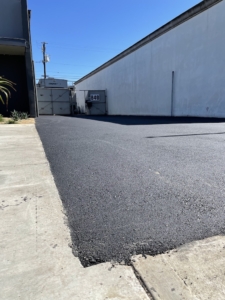Asphalt Overlays: What Is Edge Milling?
 Asphalt pavements can survive decades of use if given adequate care, but they are not eternal. At some point, you are bound to discover that numerous repairs, intermittent maintenance, or exposure to the elements may have left your pavement looking unattractive or presenting safety risks. When you do, your first thought may be that it is time to have a paving contractor tear out your old, tired pavement and reconstruct it. Before you do, you might want to consider a speedier, more economical option that can provide you with a resurfaced pavement that few people will be able to differentiate from a new one. Asphalt overlays can be an ideal solution for many structurally sound pavements that just need a surface rejuvenation.
Asphalt pavements can survive decades of use if given adequate care, but they are not eternal. At some point, you are bound to discover that numerous repairs, intermittent maintenance, or exposure to the elements may have left your pavement looking unattractive or presenting safety risks. When you do, your first thought may be that it is time to have a paving contractor tear out your old, tired pavement and reconstruct it. Before you do, you might want to consider a speedier, more economical option that can provide you with a resurfaced pavement that few people will be able to differentiate from a new one. Asphalt overlays can be an ideal solution for many structurally sound pavements that just need a surface rejuvenation.
What Are Asphalt Overlays?
An asphalt overlay is a layer of asphalt paving that is installed as part of a pavement resurfacing project. Although overlays are more commonly applied to asphalt pavements, some concrete pavements are also suitable for overlaying. Interstate highways, residential driveways, urban and suburban thoroughfares, and parking lots are just some of the types of pavements on which commercial paving contractors can install an overlay.
What Is the Connection Between Asphalt Overlays and Edge Milling?
Typically, when overlaying asphalt paving Orange County contractors use milling machines to remove the existing pavement to a depth equal to the thickness of the overlay, which is usually around three inches. Edge milling ensures that curb reveals, gutters, transitions, drain grates, and other features remain at their correct heights in relation to the surface of the pavement. Without edge milling, these features would be recessed, making for a rough ride and posing potential tripping hazards. In addition, transitions and curb ramps would likely fail to comply with the regulations contained in the Americans with Disabilities Act.
What Are the Requirements for a Successful Asphalt Overlay Installation?
In theory, an asphalt contractor could place an overlay on virtually any pavement, but the results would be short-lived, unsightly, or both unless certain requirements are met. One is that the pavement has a relatively stable and strong foundation. Another requirement for pavement resurfacing success is that any necessary repairs to the pavement are completed first. If the pavement has suffered unusually rapid damage or premature deterioration, the cause should be identified to prevent the damage from happening to the overlay. If pavement or foundation damage is extensive, reconstruction may be more cost-effective than resurfacing. Typically, a parking lot paving contractor, for example, will recommend rebuilding the pavement instead of overlaying it if the damage affects more than about 30% of the pavement’s total square footage.
For an Asphalt Contractor You Can Trust, Contact Peterson Grading & Paving
Peterson Grading & Paving is full-service commercial paving company with an immaculate reputation for consistently providing high-quality work and superior customer service throughout Orange County and California. Our services include asphalt paving and overlaying, parking lot striping, asphalt milling, concrete paving and repair, asphalt sealcoating, marking removal, parking lot signs, asphalt crack repair, shot blasting, asphalt repair, bollards, and warehouse striping. To request a free quote, you can submit the online form, email Ryan@GradePave.com, or call 949-402-6979.





Leave a Reply
Want to join the discussion?Feel free to contribute!